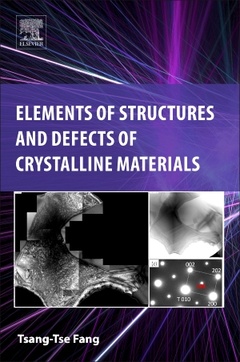Elements of Structures and Defects of Crystalline Materials
Auteur : Fang Tsang-Tse

Elements of Structures and Defects of Crystalline Materials has been written to cover not only the fundamental principles behind structures and defects, but also to provide deep insights into understanding the relationships of properties, defect chemistry and processing of the concerned materials. Part One deals with structures, while Part Two covers defects. Since the knowledge of the electron configuration of elements is necessary for understanding the nature of chemical bonding, it is discussed in the opening chapter. Chapter Two then describes the bonding formation within the crystal structures of varied materials, with Chapter Three delving into how a material?s structure is formed.
In view of the importance of the effects of the structure distortion on the material properties due to the fields, the related topics have been included in section 3.4. Moreover, several materials still under intensive investigation have been illustrated to provide deep insights into understanding the effects of the relationships of processing, structures and defects on the material properties.
The defects of materials are explored in Part II. Chapter 4 deals with the point defects of metal and ceramics. Chapter 5 covers the fundamentals of the characteristics of dislocations, wherein physics and the atomic mechanics of several issues have been described in detail. In view of the significant influence of the morphologies including size, shape and distribution of grains, phases on the microstructure evolution, and, in turn, the properties of materials, the final chapter focuses on the fundamentals of interface energies, including single phase (grain) boundary and interphase boundary.
Part I Structure of the Crystalline Materials1. The electron configuration of atoms2. Bonding within crystal structures3. The structures of crystalline crystals
Part II Defects of Crystalline Materials4. Point defects in crystalline materials5. Line defects in crystalline solids6. Two-dimensional (interfaces) and three-dimensional (second phases) imperfections in solids
Research scientists and engineers, as well as graduate students in the field of engineering and materials
- Discusses the relationship between properties, defect chemistry and the processing of materials
- Presents coverage of the fundamental principles behind structures and defects
- Includes information on two-dimensional and three-dimensional imperfections in solids
Date de parution : 01-2018
Ouvrage de 230 p.
15x22.8 cm
Thème d’Elements of Structures and Defects of Crystalline Materials :
Mots-clés :
Acceptor; BiFeO3; Bonding; Burgers vector; CaCu3Ti4O12; Capillary forces; Coherent boundary; Coincidence site lattice; Covalent bonds; Crystal fields; D-orbital collapse; Defect association; Defect chemistry; Defect structures; Dislocations; Donor; Elastic modulus; Electron configuration; Extended dislocations; Fully-filled orbital; Grain boundaries; Half-filled orbital; Hume-Rothery rules; Induced dipoles; Ionic bonds; Jahn-Teller distortions; Kröger-Vink diagram; Lattice energy; LiMn2O4; Madelung energy; Magnetite; Manganite; Metallic bonds; Ostwald ripening process; Partial dislocations; Pauling's rules; Peach-Koehler equation; Penetration; Perovskite; Point defects; Potential well; Radial distribution function; Shielding; Sintering; Solid solutions; Spinel; Spin-orbital coupling; Sr2FeMoO6; SrBaNb2O6; Stacking faults; Structures; The Born-Haber cycle; Thermal expansion; Tilt boundary; Transition metals; Twist boundary; Virtual force; Wetting; YBa2Cu3O7−x; Zero-point energy



